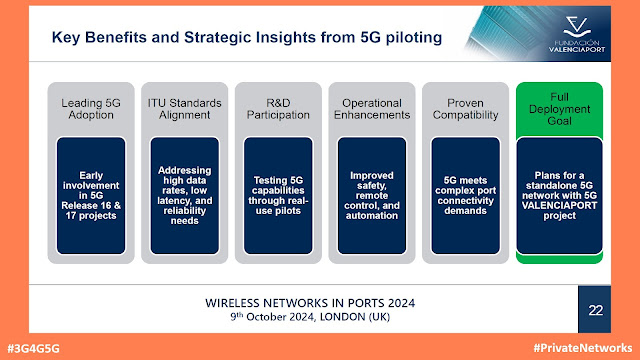Valenciaport has unveiled its private 5G network, a foundational move to transform the Port of València into a "smart port" and a leading model of Port 4.0 technology. The new network is designed to provide powerful, efficient, and secure connectivity, eliminating dependence on external operators while connecting over 25,000 devices across the port, including phones, vehicles, surveillance systems, drones, and IoT sensors.
This project, co-financed by the Connecting Europe Facility (CEF) with a budget nearing €6 million, leverages regulated n40 frequencies (2.3–2.4 GHz) to ensure secure, private, and customizable connectivity within the port's operational areas.
Why a Private 5G Network?
The decision to implement a completely private 5G SA network gives Valenciaport unilateral control over infrastructure evolution, upgrades, and management. This independence ensures alignment with the port's strategic goals and flexibility to adapt to technological and market shifts.
Key Advantages:
- Total control over security policies
- Exclusive use of radio spectrum under a self-provisioning model
- High performance and reliability for mission-critical applications
Technical Overview
Infrastructure and Coverage
The network's deployment involves 15+ n40 base stations, some with multi-sector configurations, ensuring near-complete coverage of the port's facilities. The network operates in Stand-Alone (SA) mode, integrating:
- Core network components
- RAN (Radio Access Network)
- Routing and switching systems
The infrastructure includes a geo-redundant core network, a 10 Gbps throughput capacity, and high availability cyber security. Designed for scalability, the current bandwidth of 20 MHz can expand to 40 MHz as demand grows.
Use Cases in Development
Initial use cases highlight the potential of the 5G network for operational improvements:
- Surveillance Systems: High-resolution, real-time video from mobile surveillance units and police wearables will enhance perimeter and internal security.
- Remote Maintenance: Immersive telepresence systems, powered by AI at the network core, will enable technicians to perform tasks remotely with real-time expert guidance.
Future implementations include digital twinning, collision risk detection, stowage planning, and enhanced passenger connectivity.
Building a Future-Proof Port
Joan Meseguer Llopis, Senior Manager of Innovation Projects at Valenciaport Foundation, emphasizes that the initiative is a pioneering model in Europe. By combining private spectrum use, comprehensive 5G deployment, and a large-scale operational environment, the project sets a new benchmark for port innovation.
Valenciaport's 5G network not only enhances current operations but also positions the port as a hub for future technological advancements, ensuring adaptability to new market and technology trends well beyond 2027.
This landmark project underscores the transformative role of 5G in logistics, infrastructure, and smart port ecosystems, solidifying the Port of València's status as a leader in innovation.



Comments
Post a Comment